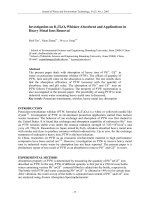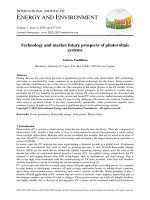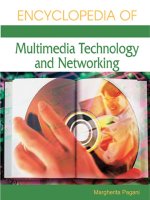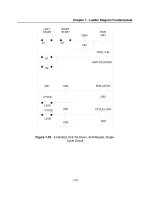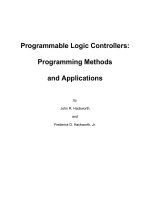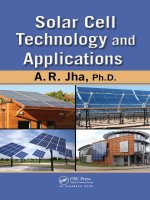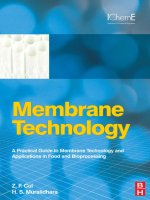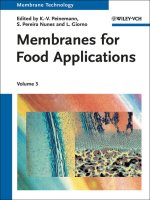membrane technology and applications
Bạn đang xem bản rút gọn của tài liệu. Xem và tải ngay bản đầy đủ của tài liệu tại đây (4.37 MB, 545 trang )
MEMBRANE
TECHNOLOGY
AND APPLICATIONS
SECOND EDITION
Richard W. Baker
Membrane Technology and Research, Inc.
Menlo Park, California
MEMBRANE
TECHNOLOGY
AND APPLICATIONS
MEMBRANE
TECHNOLOGY
AND APPLICATIONS
SECOND EDITION
Richard W. Baker
Membrane Technology and Research, Inc.
Menlo Park, California
First Edition published by McGraw-Hill, 2000. ISBN: 0 07 135440 9
Copyright
2004 John Wiley & Sons Ltd, The Atrium, Southern Gate, Chichester,
West Sussex PO19 8SQ, England
Telephone (+44) 1243 779777
Email (for orders and customer service enquiries):
Visit our Home Page on www.wileyeurope.com or www.wiley.com
All Rights Reserved. No part of this publication may be reproduced, stored in a retrieval system or
transmitted in any form or by any means, electronic, mechanical, photocopying, recording,
scanning or otherwise, except under the terms of the Copyright, Designs and Patents Act 1988 or
under the terms of a licence issued by the Copyright Licensing Agency Ltd, 90 Tottenham Court
Road, London W1T 4LP, UK, without the permission in writing of the Publisher. Requests to the
Publisher should be addressed to the Permissions Department, John Wiley & Sons Ltd, The
Atrium, Southern Gate, Chichester, West Sussex PO19 8SQ, England, or emailed to
, or faxed to (+44) 1243 770620.
This publication is designed to provide accurate and authoritative information in regard to the
subject matter covered. It is sold on the understanding that the Publisher is not engaged in
rendering professional services. If professional advice or other expert assistance is required, the
services of a competent professional should be sought.
Other Wiley Editorial Offices
John Wiley & Sons Inc., 111 River Street, Hoboken, NJ 07030, USA
Jossey-Bass, 989 Market Street, San Francisco, CA 94103-1741, USA
Wiley-VCH Verlag GmbH, Boschstr. 12, D-69469 Weinheim, Germany
John Wiley & Sons Australia Ltd, 33 Park Road, Milton, Queensland 4064, Australia
John Wiley & Sons (Asia) Pte Ltd, 2 Clementi Loop #02-01, Jin Xing Distripark, Singapore 129809
John Wiley & Sons Canada Ltd, 22 Worcester Road, Etobicoke, Ontario, Canada M9W 1L1
Wiley also publishes its books in a variety of electronic formats. Some content that appears
in print may not be available in electronic books.
Library of Congress Cataloging-in-Publication Data
Baker, Richard W.
Membrane technology and applications / Richard W. Baker.—2nd ed.
p. cm.
Includes bibliographical references and index.
ISBN 0-470-85445-6 (Cloth : alk. paper)
1. Membranes (Technology) I. Title.
TP159.M4 B35 2004
660
.28424—dc22
2003021354
British Library Cataloguing in Publication Data
A catalogue record for this book is available from the British Library
ISBN 0-470-85445-6
Typeset in 10/12pt Times by Laserwords Private Limited, Chennai, India
Printed and bound in Great Britain by TJ International, Padstow, Cornwall
This book is printed on acid-free paper responsibly manufactured from sustainable forestry
in which at least two trees are planted for each one used for paper production.
CONTENTS
Preface ix
Acknowledgments for the first edition xi
Acknowledgments for the second edition xiii
1. OVERVIEW OF MEMBRANE SCIENCE AND TECHNOLOGY 1
Introduction 1
Historical Development of Membranes 1
Types of Membranes 3
Membrane Processes 6
References 14
2. MEMBRANE TRANSPORT THEORY 15
Introduction 15
Solution-diffusion Model 18
Structure–Permeability Relationships in Solution-diffusion
Membranes 48
Pore-flow Membranes 66
Conclusions and Future Directions 83
References 84
3. MEMBRANES AND MODULES 89
Introduction 89
Isotropic Membranes 90
Anisotropic Membranes 96
Metal Membranes and Ceramic Membranes 128
Liquid Membranes 132
Hollow Fiber Membranes 133
Membrane Modules 139
Conclusions and Future Directions 154
References 155
4. CONCENTRATION POLARIZATION 161
Introduction 161
Boundary Layer Film Model 164
vi CONTENTS
Determination of the Peclet Number 172
Concentration Polarization in Liquid Separation Processes 176
Concentration Polarization in Gas Separation Processes 178
Cross-flow, Co-flow and Counter-flow 182
Conclusions and Future Directions 189
References 189
5. REVERSE OSMOSIS 191
Introduction and History 191
Theoretical Background 193
Membranes and Materials 196
Reverse Osmosis Membrane Categories 205
Membrane Selectivity 212
Membrane Modules 214
Membrane Fouling Control 215
Membrane Cleaning 220
Applications 221
Conclusions and Future Directions 231
References 232
6. ULTRAFILTRATION 237
Introduction and History 237
Characterization of Ultrafiltration Membranes 238
Concentration Polarization and Membrane Fouling 241
Membrane Cleaning 251
Membranes and Modules 253
System Design 258
Applications 262
Conclusions and Future Directions 272
References 272
7. MICROFILTRATION 275
Introduction and History 275
Background 277
Applications 295
Conclusions and Future Directions 299
References 299
8. GAS SEPARATION 301
Introduction and History 301
Theoretical Background 303
Membrane Materials and Structure 309
Membrane Modules 317
CONTENTS vii
Process Design 317
Applications 327
Conclusions and Future Directions 349
References 351
9. PERVAPORATION 355
Introduction and History 355
Theoretical Background 357
Membrane Materials and Modules 363
Process Design 369
Applications 372
Conclusions and Future Directions 388
References 389
10. ION EXCHANGE MEMBRANE
PROCESSES–ELECTRODIALYSIS 393
Introduction and History 393
Theoretical Background 397
Chemistry of Ion Exchange Membranes 400
Transport in Electrodialysis Membranes 404
System Design 411
Applications 415
Conclusions and Future Directions 422
References 422
11. CARRIER FACILITATED TRANSPORT 425
Introduction and History 425
Coupled Transport 431
Facilitated Transport 444
Conclusions and Future Directions 459
References 460
12. MEDICAL APPLICATIONS OF MEMBRANES 465
Introduction 465
Hemodialysis 465
Blood Oxygenators 470
Controlled Drug Delivery 472
References 489
13. OTHER MEMBRANE PROCESSES 491
Introduction 491
Dialysis 491
Donnan Dialysis and Diffusion Dialysis 493
viii CONTENTS
Charge Mosaic Membranes and Piezodialysis 496
Membrane Contactors and Membrane Distillation 500
Membrane Reactors 509
Conclusions and Future Directions 518
References 519
Appendix 523
Index 535
PREFACE
My introduction to membranes was as a graduate student in 1963. At that time
membrane permeation was a sub-study of materials science. What is now called
membrane technology did not exist, nor did any large industrial applications
of membranes. Since then, sales of membranes and membrane equipment have
increased more than 100-fold and several tens of millions of square meters of
membrane are produced each year—a membrane industry has been created.
This membrane industry is very fragmented. Industrial applications are divided
into six main sub-groups: reverse osmosis; ultrafiltration; microfiltration; gas sep-
aration; pervaporation and electrodialysis. Medical applications are divided into
three more: artificial kidneys; blood oxygenators; and controlled release phar-
maceuticals. Few companies are involved in more than one sub-group of the
industry. Because of these divisions it is difficult to obtain an overview of mem-
brane science and technology; this book is an attempt to give such an overview.
The book starts with a series of general chapters on membrane preparation,
transport theory, and concentration polarization. Thereafter, each major mem-
brane application is treated in a single 20-to-40-page chapter. In a book of this
size it is impossible to describe every membrane process in detail, but the major
processes are covered. However, medical applications have been short-changed
somewhat and some applications—fuel cell and battery separators and membrane
sensors, for example—are not covered at all.
Each application chapter starts with a short historical background to acknowl-
edge the developers of the technology. I am conscious that my views of what
was important in the past differ from those of many of my academic colleagues.
In this book I have given more credit than is usual to the engineers who actually
made the processes work.
Readers of the theoretical section (Chapter 2) and elsewhere in the book
will see that membrane permeation is described using simple phenomenologi-
cal equations, most commonly, Fick’s law. There is no mention of irreversible
thermodynamics. The irreversible thermodynamic approach to permeation was
very fashionable when I began to work with membranes in the 1960s. This
approach has the appearance of rigor but hides the physical reality of even simple
processes behind a fog of tough equations. As a student and young researcher, I
struggled with irreversible thermodynamics for more than 15 years before finally
giving up in the 1970s. I have lived happily ever after.
xPREFACE
Finally, a few words on units. Because a great deal of modern membrane tech-
nology originated in the United States, the US engineering units—gallons, cubic
feet, and pounds per square inch—are widely used in the membrane industry.
Unlike the creators of the Pascal, I am not a worshipper of mindless uniformity.
Metric units are used when appropriate, but US engineering units are used when
they are the industry standard.
ACKNOWLEDGMENTS FOR
THE FIRST EDITION
As a school boy I once received a mark of
1
2
out of a possible 20 in an end-of-term
spelling test. My spelling is still weak, and the only punctuation I ever really
mastered was the period. This made the preparation of a polished final draft from
my yellow notepads a major undertaking. This effort was headed by Tessa Ennals
and Cindi Wieselman. Cindi typed and retyped the manuscript with amazing
speed, through its numerous revisions, without complaint. Tessa corrected my
English, clarified my language, unsplit my infinitives and added every semicolon
found in this book. She also chased down a source for all of the illustrations used
and worked with David Lehmann, our graphics artist, to prepare the figures. It is
a pleasure to acknowledge my debt to these people. This book would have been
far weaker without the many hours they spent working on it. I also received help
from other friends and colleagues at MTR. Hans Wijmans read, corrected and
made numerous suggestions on the theoretical section of the book (Chapter 2).
Ingo Pinnau also provided data, references and many valuable suggestions in
the area of membrane preparation and membrane material sciences. I am also
grateful to Kenji Matsumoto, who read the section on Reverse Osmosis and made
corrections, and to Heiner Strathmann, who did the same for Electrodialysis. The
assistance of Marcia Patten, who proofed the manuscript, and Vivian Tran, who
checked many of the references, is also appreciated.
ACKNOWLEDGMENTS FOR
THE SECOND EDITION
Eighteen months after the first edition of this book appeared, it was out of print.
Fortunately, John Wiley & Sons, Ltd agreed to publish a second edition, and
I have taken the opportunity to update and revise a number of sections. Tessa
Ennals, long-time editor at Membrane Technology and Research, postponed her
retirement to help me finish the new edition. Tessa has the standards of an earlier
time, and here, as in the past, she gave the task nothing but her best effort. I am
indebted to her, and wish her a long and happy retirement. Marcia Patten, Eric
Peterson, David Lehmann, Cindy Dunnegan and Janet Farrant assisted Tessa by
typing new sections, revising and adding figures, and checking references, as well
as helping with proofing the manuscript. I am grateful to all of these colleagues
for their help.
1 OVERVIEW OF MEMBRANE
SCIENCE AND TECHNOLOGY
Introduction
Membranes have gained an important place in chemical technology and are used
in a broad range of applications. The key property that is exploited is the ability
of a membrane to control the permeation rate of a chemical species through the
membrane. In controlled drug delivery, the goal is to moderate the permeation
rate of a drug from a reservoir to the body. In separation applications, the goal
is to allow one component of a mixture to permeate the membrane freely, while
hindering permeation of other components.
This book provides a general introduction to membrane science and technology.
Chapters 2 to 4 cover membrane science, that is, topics that are basic to all
membrane processes, such as transport mechanisms, membrane preparation, and
boundary layer effects. The next six chapters cover the industrial membrane
separation processes, which represent the heart of current membrane technology.
Carrier facilitated transport is covered next, followed by a chapter reviewing the
medical applications of membranes. The book closes with a chapter that describes
various minor or yet-to-be-developed membrane processes, including membrane
reactors, membrane contactors and piezodialysis.
Historical Development of Membranes
Systematic studies of membrane phenomena can be traced to the eighteenth cen-
tury philosopher scientists. For example, Abb
´
e Nolet coined the word ‘osmosis’
to describe permeation of water through a diaphragm in 1748. Through the nine-
teenth and early twentieth centuries, membranes had no industrial or commercial
uses, but were used as laboratory tools to develop physical/chemical theories. For
example, the measurements of solution osmotic pressure made with membranes
by Traube and Pfeffer were used by van’t Hoff in 1887 to develop his limit law,
which explains the behavior of ideal dilute solutions; this work led directly to the
Membrane Technology and Applications R. W. Baker
2004 John Wiley & Sons, Ltd ISBN: 0-470-85445-6
2MEMBRANE TECHNOLOGY AND APPLICATIONS
van’t Hoff equation. At about the same time, the concept of a perfectly selective
semipermeable membrane was used by Maxwell and others in developing the
kinetic theory of gases.
Early membrane investigators experimented with every type of diaphragm
available to them, such as bladders of pigs, cattle or fish and sausage casings
made of animal gut. Later, collodion (nitrocellulose) membranes were preferred,
because they could be made reproducibly. In 1907, Bechhold devised a technique
to prepare nitrocellulose membranes of graded pore size, which he determined
by a bubble test [1]. Other early workers, particularly Elford [2], Zsigmondy and
Bachmann [3] and Ferry [4] improved on Bechhold’s technique, and by the early
1930s microporous collodion membranes were commercially available. During
the next 20 years, this early microfiltration membrane technology was expanded
to other polymers, notably cellulose acetate. Membranes found their first signif-
icant application in the testing of drinking water at the end of World War II.
Drinking water supplies serving large communities in Germany and elsewhere
in Europe had broken down, and filters to test for water safety were needed
urgently. The research effort to develop these filters, sponsored by the US Army,
was later exploited by the Millipore Corporation, the first and still the largest US
microfiltration membrane producer.
By 1960, the elements of modern membrane science had been developed, but
membranes were used in only a few laboratory and small, specialized industrial
applications. No significant membrane industry existed, and total annual sales of
membranes for all industrial applications probably did not exceed US$20 million
in 2003 dollars. Membranes suffered from four problems that prohibited their
widespread use as a separation process: They were too unreliable, too slow, too
unselective, and too expensive. Solutions to each of these problems have been
developed during the last 30 years, and membrane-based separation processes
are now commonplace.
The seminal discovery that transformed membrane separation from a labora-
tory to an industrial process was the development, in the early 1960s, of the
Loeb–Sourirajan process for making defect-free, high-flux, anisotropic reverse
osmosis membranes [5]. These membranes consist of an ultrathin, selective sur-
face film on a much thicker but much more permeable microporous support,
which provides the mechanical strength. The flux of the first Loeb–Sourirajan
reverse osmosis membrane was 10 times higher than that of any membrane then
available and made reverse osmosis a potentially practical method of desalting
water. The work of Loeb and Sourirajan, and the timely infusion of large sums
of research and development dollars from the US Department of Interior, Office
of Saline Water (OSW), resulted in the commercialization of reverse osmosis and
was a major factor in the development of ultrafiltration and microfiltration. The
development of electrodialysis was also aided by OSW funding.
Concurrently with the development of these industrial applications of mem-
branes was the independent development of membranes for medical separation
OVERVIEW OF MEMBRANE SCIENCE AND TECHNOLOGY 3
processes, in particular, the artificial kidney. W.J. Kolf [6] had demonstrated
the first successful artificial kidney in The Netherlands in 1945. It took almost
20 years to refine the technology for use on a large scale, but these developments
were complete by the early 1960s. Since then, the use of membranes in artifi-
cial organs has become a major life-saving procedure. More than 800 000 people
are now sustained by artificial kidneys and a further million people undergo
open-heart surgery each year, a procedure made possible by development of the
membrane blood oxygenator. The sales of these devices comfortably exceed the
total industrial membrane separation market. Another important medical applica-
tion of membranes is for controlled drug delivery systems. A key figure in this
area was Alex Zaffaroni, who founded Alza, a company dedicated to develop-
ing these products in 1966. The membrane techniques developed by Alza and
its competitors are widely used in the pharmaceutical industry to improve the
efficiency and safety of drug delivery.
The period from 1960 to 1980 produced a significant change in the status
of membrane technology. Building on the original Loeb–Sourirajan technique,
other membrane formation processes, including interfacial polymerization and
multilayer composite casting and coating, were developed for making high-
performance membranes. Using these processes, membranes with selective layers
as thin as 0.1 µm or less are now being produced by a number of compa-
nies. Methods of packaging membranes into large-membrane-area spiral-wound,
hollow-fine-fiber, capillary, and plate-and-frame modules were also developed,
and advances were made in improving membrane stability. By 1980, micro-
filtration, ultrafiltration, reverse osmosis and electrodialysis were all established
processes with large plants installed worldwide.
The principal development in the 1980s was the emergence of industrial mem-
brane gas separation processes. The first major development was the Monsanto
Prism
membrane for hydrogen separation, introduced in 1980 [7]. Within a few
years, Dow was producing systems to separate nitrogen from air, and Cynara and
Separex were producing systems to separate carbon dioxide from natural gas.
Gas separation technology is evolving and expanding rapidly; further substantial
growth will be seen in the coming years. The final development of the 1980s was
the introduction by GFT, a small German engineering company, of the first com-
mercial pervaporation systems for dehydration of alcohol. More than 100 ethanol
and isopropanol pervaporation dehydration plants have now been installed. Other
pervaporation applications are at the early commercial stage.
Types of Membranes
This book is limited to synthetic membranes, excluding all biological structures,
but the topic is still large enough to include a wide variety of membranes that dif-
fer in chemical and physical composition and in the way they operate. In essence,
a membrane is nothing more than a discrete, thin interface that moderates the
4MEMBRANE TECHNOLOGY AND APPLICATIONS
coo
-
coo
-
coo
-
coo
-
coo
-
coo
-
coo
-
coo
-
coo
-
coo
-
coo
-
coo
-
Isotropic microporous
membrane
Nonporous dense
membrane
Electrically charged
membrane
Anisotropic membranes
Supported liquid
membrane
Thin-film composite
anisotropic membrane
Polymer
matrix
Liquid-
filled
pores
Loeb-Sourirajan
anisotropic membrane
Symmetrical membranes
Figure 1.1 Schematic diagrams of the principal types of membranes
permeation of chemical species in contact with it. This interface may be molecu-
larly homogeneous, that is, completely uniform in composition and structure, or
it may be chemically or physically heterogeneous, for example, containing holes
or pores of finite dimensions or consisting of some form of layered structure. A
normal filter meets this definition of a membrane, but, by convention, the term
filter is usually limited to structures that separate particulate suspensions larger
than1to10µm. The principal types of membrane are shown schematically in
Figure 1.1 and are described briefly below.
Isotropic Membranes
Microporous Membranes
A microporous membrane is very similar in structure and function to a conven-
tional filter. It has a rigid, highly voided structure with randomly distributed,
interconnected pores. However, these pores differ from those in a conventional
filter by being extremely small, on the order of 0.01 to 10 µm in diameter. All
particles larger than the largest pores are completely rejected by the membrane.
OVERVIEW OF MEMBRANE SCIENCE AND TECHNOLOGY 5
Particles smaller than the largest pores, but larger than the smallest pores are
partially rejected, according to the pore size distribution of the membrane. Par-
ticles much smaller than the smallest pores will pass through the membrane.
Thus, separation of solutes by microporous membranes is mainly a function of
molecular size and pore size distribution. In general, only molecules that differ
considerably in size can be separated effectively by microporous membranes, for
example, in ultrafiltration and microfiltration.
Nonporous, Dense Membranes
Nonporous, dense membranes consist of a dense film through which permeants
are transported by diffusion under the driving force of a pressure, concentra-
tion, or electrical potential gradient. The separation of various components of a
mixture is related directly to their relative transport rate within the membrane,
which is determined by their diffusivity and solubility in the membrane material.
Thus, nonporous, dense membranes can separate permeants of similar size if their
concentration in the membrane material (that is, their solubility) differs signifi-
cantly. Most gas separation, pervaporation, and reverse osmosis membranes use
dense membranes to perform the separation. Usually these membranes have an
anisotropic structure to improve the flux.
Electrically Charged Membranes
Electrically charged membranes can be dense or microporous, but are most com-
monly very finely microporous, with the pore walls carrying fixed positively
or negatively charged ions. A membrane with fixed positively charged ions is
referred to as an anion-exchange membrane because it binds anions in the sur-
rounding fluid. Similarly, a membrane containing fixed negatively charged ions
is called a cation-exchange membrane. Separation with charged membranes is
achieved mainly by exclusion of ions of the same charge as the fixed ions of the
membrane structure, and to a much lesser extent by the pore size. The separation
is affected by the charge and concentration of the ions in solution. For example,
monovalent ions are excluded less effectively than divalent ions and, in solutions
of high ionic strength, selectivity decreases. Electrically charged membranes are
used for processing electrolyte solutions in electrodialysis.
Anisotropic Membranes
The transport rate of a species through a membrane is inversely proportional to
the membrane thickness. High transport rates are desirable in membrane separa-
tion processes for economic reasons; therefore, the membrane should be as thin as
possible. Conventional film fabrication technology limits manufacture of mechan-
ically strong, defect-free films to about 20 µm thickness. The development of
6MEMBRANE TECHNOLOGY AND APPLICATIONS
novel membrane fabrication techniques to produce anisotropic membrane struc-
tures was one of the major breakthroughs of membrane technology during the
past 30 years. Anisotropic membranes consist of an extremely thin surface layer
supported on a much thicker, porous substructure. The surface layer and its
substructure may be formed in a single operation or separately. In composite
membranes, the layers are usually made from different polymers. The separation
properties and permeation rates of the membrane are determined exclusively by
the surface layer; the substructure functions as a mechanical support. The advan-
tages of the higher fluxes provided by anisotropic membranes are so great that
almost all commercial processes use such membranes.
Ceramic, Metal and Liquid Membranes
The discussion so far implies that membrane materials are organic polymers and,
in fact, the vast majority of membranes used commercially are polymer-based.
However, in recent years, interest in membranes formed from less conventional
materials has increased. Ceramic membranes, a special class of microporous
membranes, are being used in ultrafiltration and microfiltration applications for
which solvent resistance and thermal stability are required. Dense metal mem-
branes, particularly palladium membranes, are being considered for the separation
of hydrogen from gas mixtures, and supported liquid films are being developed
for carrier-facilitated transport processes.
Membrane Processes
Six developed and a number of developing and yet-to-be-developed industrial
membrane technologies are discussed in this book. In addition, sections are
included describing the use of membranes in medical applications such as the
artificial kidney, blood oxygenation, and controlled drug delivery devices. The
status of all of these processes is summarized in Table 1.1.
The four developed industrial membrane separation processes are microfiltra-
tion, ultrafiltration, reverse osmosis, and electrodialysis. These processes are all
well established, and the market is served by a number of experienced companies.
The range of application of the three pressure-driven membrane water sep-
aration processes—reverse osmosis, ultrafiltration and microfiltration—is illus-
trated in Figure 1.2. Ultrafiltration (Chapter 6) and microfiltration (Chapter 7)
are basically similar in that the mode of separation is molecular sieving through
increasingly fine pores. Microfiltration membranes filter colloidal particles and
bacteria from 0.1 to 10 µm in diameter. Ultrafiltration membranes can be used
to filter dissolved macromolecules, such as proteins, from solutions. The mech-
anism of separation by reverse osmosis membranes is quite different. In reverse
osmosis membranes (Chapter 5), the membrane pores are so small, from 3 to
5
˚
A in diameter, that they are within the range of thermal motion of the polymer
OVERVIEW OF MEMBRANE SCIENCE AND TECHNOLOGY 7
Table 1.1 Membrane technologies addressed in this book
Category Process Status
Developed industrial
membrane separation
technologies
Microfiltration
Ultrafiltration
Reverse osmosis
Electrodialysis
Well-established unit
operations. No major
breakthroughs seem
imminent
Developing industrial
membrane separation
technologies
Gas separation
Pervaporation
A number of plants have been
installed. Market size and
number of applications
served are expanding
To-be-developed
industrial membrane
separation
technologies
Carrier facilitated
transport
Membrane contactors
Piezodialysis, etc.
Major problems remain to be
solved before industrial
systems will be installed on
a large scale
Medical applications of
membranes
Artificial kidneys
Artificial lungs
Controlled drug delivery
Well-established processes.
Still the focus of research to
improve performance, for
example, improving
biocompatibility
Reverse
osmosis
Ultrafiltration
Microfiltration
Conventional
filtration
1 Å 10 Å 100 Å 1000 Å
1 µm 10 µm 100 µm
H
2
O
(2 Å)
Sucrose
(10 Å)
Hemoglobin
(70 Å)
Influenza
virus
(1000 Å)
Pseudomonas
diminuta
(0.28 µm)
Na+
(3.7 Å)
Staphylococcus
bacteria
(1 µm)
Starch
(10 µm)
Pore diameter
Figure 1.2 Reverse osmosis, ultrafiltration, microfiltration, and conventional filtration
are related processes differing principally in the average pore diameter of the membrane
filter. Reverse osmosis membranes are so dense that discrete pores do not exist; transport
occurs via statistically distributed free volume areas. The relative size of different solutes
removed by each class of membrane is illustrated in this schematic
8MEMBRANE TECHNOLOGY AND APPLICATIONS
chains that form the membrane. The accepted mechanism of transport through
these membranes is called the solution-diffusion model. According to this model,
solutes permeate the membrane by dissolving in the membrane material and
diffusing down a concentration gradient. Separation occurs because of the dif-
ference in solubilities and mobilities of different solutes in the membrane. The
principal application of reverse osmosis is desalination of brackish groundwater
or seawater.
Although reverse osmosis, ultrafiltration and microfiltration are conceptually
similar processes, the difference in pore diameter (or apparent pore diameter)
produces dramatic differences in the way the membranes are used. A simple
model of liquid flow through these membranes is to describe the membranes as
a series of cylindrical capillary pores of diameter d. The liquid flow through a
pore (q) is given by Poiseuille’s law as:
q =
πd
4
128 µ
· p (1.1)
where p is the pressure difference across the pore, µ is the liquid viscosity and
is the pore length. The flux, or flow per unit membrane area, is the sum of all
the flows through the individual pores and so is given by:
J = N ·
πd
4
128 µ
· p (1.2)
where N is the number of pores per square centimeter of membrane.
For membranes of equal pore area and porosity (ε), the number of pores per
square centimeter is proportional to the inverse square of the pore diameter.
That is,
N = ε ·
4
πd
2
(1.3)
It follows that the flux, given by combining Equations (1.2) and (1.3), is
J =
p ε
32 µ
· d
2
(1.4)
From Figure 1.2, the typical pore diameter of a microfiltration membrane
is 10 000
˚
A. This is 100-fold larger than the average ultrafiltration pore and
1000-fold larger than the (nominal) diameter of pores in reverse osmosis mem-
branes. Because fluxes are proportional to the square of these pore diameters, the
permeance, that is, flux per unit pressure difference (J /p) of microfiltration
membranes is enormously higher than that of ultrafiltration membranes, which in
turn is much higher than that of reverse osmosis membranes. These differences
significantly impact the operating pressure and the way that these membranes are
used industrially.
OVERVIEW OF MEMBRANE SCIENCE AND TECHNOLOGY 9
The fourth fully developed membrane process is electrodialysis (Chapter 10),
in which charged membranes are used to separate ions from aqueous solutions
under the driving force of an electrical potential difference. The process utilizes
an electrodialysis stack, built on the filter-press principle and containing several
hundred individual cells, each formed by a pair of anion and cation exchange
membranes. The principal application of electrodialysis is the desalting of brack-
ish groundwater. However, industrial use of the process in the food industry, for
example, to deionize cheese whey, is growing, as is its use in pollution-control
applications. A schematic of the process is shown in Figure 1.3.
Table 1.1 shows two developing industrial membrane separation processes: gas
separation with polymer membranes (Chapter 8) and pervaporation (Chapter 9).
Gas separation with membranes is the more advanced of the two techniques; at
least 20 companies worldwide offer industrial, membrane-based gas separation
systems for a variety of applications. Only a handful of companies currently offer
industrial pervaporation systems. In gas separation, a gas mixture at an elevated
pressure is passed across the surface of a membrane that is selectively permeable
to one component of the feed mixture; the membrane permeate is enriched in this
species. The basic process is illustrated in Figure 1.4. Major current applications
ACACACA
C
AC
Salt solutionPick-up solution
To positive
pole of
rectifier
Anode
feed
Anode
effluent
Demineralized productConcentrated effluent
Cathode
effluent
To negative pole
of rectifier
Cathode
(−)
Cathode
feed
Cl
−
Na
+
Na
+
Na
+
Na
+
Na
+
Na
+
Na
+
Na
+
Na
+
Cl
−
Cl
−
Cl
−
Cl
−
Cl
−
Cl
−
Cl
−
Cl
−
Anode
(+)
C
Cation-exchange
membrane
A
Anion-exchange
membrane
Figure 1.3 Schematic diagram of an electrodialysis process
10 MEMBRANE TECHNOLOGY AND APPLICATIONS
Feed Residue
Permeate
Membrane
module
Figure 1.4 Schematic diagram of the basic membrane gas separation process
of gas separation membranes are the separation of hydrogen from nitrogen, argon
and methane in ammonia plants; the production of nitrogen from air; and the
separation of carbon dioxide from methane in natural gas operations. Membrane
gas separation is an area of considerable current research interest, and the number
of applications is expanding rapidly.
Pervaporation is a relatively new process that has elements in common with
reverse osmosis and gas separation. In pervaporation, a liquid mixture contacts
one side of a membrane, and the permeate is removed as a vapor from the other.
The driving force for the process is the low vapor pressure on the permeate
side of the membrane generated by cooling and condensing the permeate vapor.
The attraction of pervaporation is that the separation obtained is proportional
to the rate of permeation of the components of the liquid mixture through the
selective membrane. Therefore, pervaporation offers the possibility of separating
closely boiling mixtures or azeotropes that are difficult to separate by distilla-
tion or other means. A schematic of a simple pervaporation process using a
condenser to generate the permeate vacuum is shown in Figure 1.5. Currently,
the main industrial application of pervaporation is the dehydration of organic
solvents, in particular, the dehydration of 90–95 % ethanol solutions, a diffi-
cult separation problem because of the ethanol–water azeotrope at 95 % ethanol.
Pervaporation membranes that selectively permeate water can produce more than
99.9 % ethanol from these solutions. Pervaporation processes are also being devel-
oped for the removal of dissolved organics from water and for the separation of
organic mixtures.
A number of other industrial membrane processes are placed in the category of
to-be-developed technologies in Table 1.1. Perhaps the most important of these is
carrier facilitated transport (Chapter 11), which often employs liquid membranes
containing a complexing or carrier agent. The carrier agent reacts with one com-
ponent of a mixture on the feed side of the membrane and then diffuses across
the membrane to release the permeant on the product side of the membrane. The
reformed carrier agent then diffuses back to the feed side of the membrane. Thus,
the carrier agent acts as a shuttle to selectively transport one component from
the feed to the product side of the membrane.
OVERVIEW OF MEMBRANE SCIENCE AND TECHNOLOGY 11
Condenser
Purified
liquid
Feed
liquid
Condensed
permeate
liquid
Figure 1.5 Schematic diagram of the basic pervaporation process
Facilitated transport membranes can be used to separate gases; membrane trans-
port is then driven by a difference in the gas partial pressure across the membrane.
Metal ions can also be selectively transported across a membrane, driven by a
flow of hydrogen or hydroxyl ions in the other direction. This process is some-
times called coupled transport. Examples of carrier facilitated transport processes
for gas and ion transport are shown in Figure 1.6.
Because the carrier facilitated transport process employs a reactive carrier
species, very high membrane selectivities can be achieved. These selectivities
are often far larger than the selectivities achieved by other membrane pro-
cesses. This one fact has maintained interest in facilitated transport for the past
30 years, but no commercial applications have developed. The principal problem
is the physical instability of the liquid membrane and the chemical instability of
the carrier agent. In recent years a number of potential solutions to this prob-
lem have been developed, which may yet make carrier facilitated transport a
viable process.
The membrane separation processes described above represent the bulk of the
industrial membrane separation industry. Another process, dialysis, is not used
industrially but is used on a large scale in medicine to remove toxic metabolites
from blood in patients suffering from kidney failure. The first successful artificial
kidney was based on cellophane (regenerated cellulose) dialysis membranes and
was developed in 1945. Over the past 50 years, many changes have been made.
Currently, most artificial kidneys are based on hollow-fiber membranes formed
into modules having a membrane area of about 1 m
2
; the process is illustrated
in Figure 1.7. Blood is circulated through the center of the fiber, while isotonic
12 MEMBRANE TECHNOLOGY AND APPLICATIONS
O
2
O
2
O
2
+ HEM [HEM O
2
]
[HEM O
2
] HEM + O
2
Cu
++
Coupled transport
Facilitated transport
H
+
Cu
++
+ 2HR CuR
2
+ 2H
+
H
+
HR
Cu
++
[HEM O
2
]
CuR
2
HEM
Membrane
Membrane
CuR
2
+ 2H
+
Cu
++
+ 2HR
Figure 1.6 Schematic examples of carrier facilitated transport of gas and ions. The gas
transport example shows the transport of oxygen across a membrane using hemoglobin
as the carrier agent. The ion transport example shows the transport of copper ions across
a membrane using a liquid ion-exchange reagent as the carrier agent
Saline
solution
BloodBlood
Saline
and
metabolites
Dialyser
Figure 1.7 Schematic of a hollow fiber artificial kidney dialyser used to remove urea
and other toxic metabolites from blood. About 100 million of these devices are used
every year
